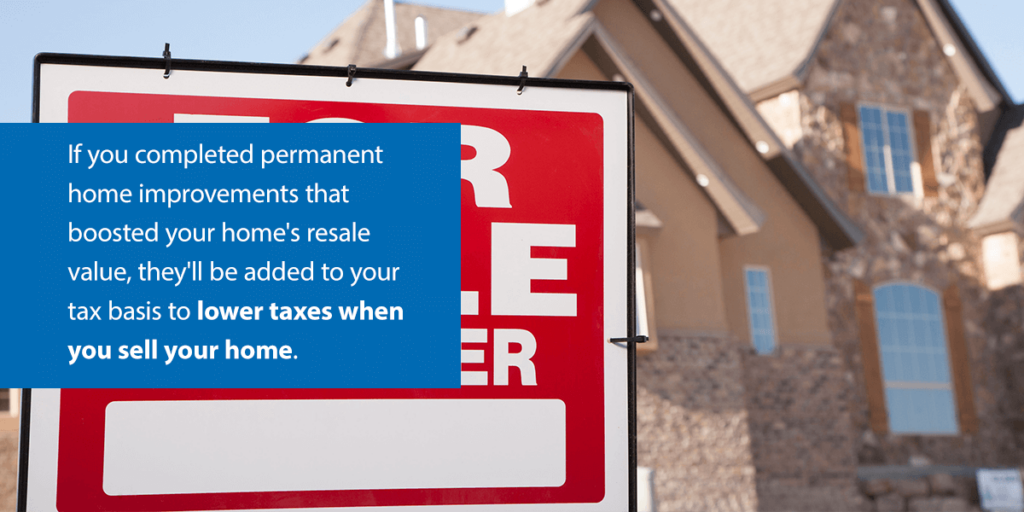

It’s no secret that home projects and renovations can be expensive, so you might be wondering if you can deduct these costs from your taxes. To determine whether you can receive tax breaks on these upgrades, it’s important to understand what qualifies as a tax-deductible home improvement. Find out if you can write off certain renovations, like new flooring, in this article.
What Is Considered a Tax-Deductible Home Improvement?
The Internal Revenue Service considers any upgrade that increases your home’s value, prolongs its life or adapts it to new uses a tax-deductible home improvement. Some examples of tax-deductible home improvements include:
- Adding a second story or room to your home.
- Upgrading your heating or cooling system.
- Installing new wiring or plumbing.
- Installing built-in appliances.
- Building a porch, patio or deck.
- Adding a swimming pool.
- Adding a driveway.
Are All Home Improvements Tax Deductible?
Technically, no. Any repair- or maintenance-related expense that’s necessary to maintain your home’s condition — but doesn’t improve its value or life span — isn’t considered a tax-deductible home improvement. Some examples include:
- Replacing broken hardware.
- Filling a hole or crack.
- Fixing a leak.
- Replacing loose shingles.
Keep in mind that most tax-deductible home improvements, such as replacing the roof or installing central air conditioning, aren’t deductible during the year you spend the money. You also can’t deduct these costs if you use your home as your personal residence, as they’re considered nondeductible personal expenses.
However, keeping track of these expenses may help you reduce your taxes when you sell your home. Home improvement-related costs contribute to your home’s tax basis, or the amount of investment in your home for tax purposes. The greater your tax basis, the less profit you’ll get when selling your home, thus lowering your tax liability.
Remember that your home’s basis doesn’t include expenses from improvements that were later removed from the home. For instance, if you installed a fence several years ago and then replaced it, the old fence is no longer included in the home’s basis.
Many homeowners use home improvements to increase their basis. There are also other exceptions eligible for home improvement tax write-offs, which we’ll explore below.
Is New Flooring Tax Deductible?
Like any other home improvement, new flooring isn’t tax deductible when it’s used for your personal residence. However, below are three instances where you may be able to deduct new flooring — like hardwood floors, wall-to-wall carpet, or luxury vinyl tile flooring — from your taxes.
1. Working From Home
If you’re a homeowner with a small office or basic working space at your residence, you can’t deduct any improvements made to your home office. However, using any part of your home regularly and exclusively for operating a business means you can deduct 100% of your home office renovations. These improvements include anything from installing new flooring and windows to adding new lighting and painting — you just need to have a legitimate business and provide documentation to qualify for these deductions.
Certain improvements and repairs made to other parts of your home may even be partially deductible, as you run a business from your property, which must be fully functioning to maintain success. The general rule is that if your office occupies 10% of your home, you can deduct 10% of home-related expenses. These costs can be deducted in the same year they were completed.
2. Renting out a Home
If you’re a landlord, you may be able to deduct property additions or improvements from your taxes, including new flooring. What’s more, they don’t need to be upgrades that add significant value, like many tax-deductible renovations.
While home repairs aren’t usually tax-deductible, a rental property’s repair expenses are fully deductible during the year they’re performed, assuming they’re priced reasonably and necessary to maintain a livable space for tenants. If you rent out your home temporarily for vacation purposes, you can deduct costs proportionate to the number of days each year and the amount of home space you rent out, whether it’s a single room or your entire house.
Be sure to note the difference between improvements and repairs for tax purposes. For instance, if your rental property has a roof leak and you pay to have it repaired, you can deduct the full expense. However, if you replace the roof, you can deduct the cost over multiple years.
3. Selling a House


As mentioned above, you can deduct home improvements like new flooring when you sell your house, as they add value to the property. If you completed permanent home improvements that boosted your home’s resale value, they’ll be added to your tax basis to lower taxes when you sell your home.
These costs aren’t deductible in the year they’re spent, whether they’re from smaller upgrades or large projects. If permitted in your area, you can also fully deduct payments made each year on a home improvement loan.
When and How Can You Get Tax Deductions?
You can claim home improvement tax deductions when filing your taxes. There are generally two ways to claim deductions:
- Standard: The standard deduction is a fixed dollar amount in your adjusted gross income (AGI) that reduces your taxed income. Your standard deduction depends on your filing status.
- Itemized: Itemized deductions also reduce your AGI, but their dollar amount varies for each taxpayer. You calculate itemized deductions by adding up all deductions you qualify for and subtracting this number from your taxable income. The more you can deduct, the less you’ll pay in taxes.
Remember to keep records of your renovations so you can deduct the costs during the next tax season. Additionally, make sure you know your eligibility for tax deductions before you file. If you’re unsure about whether you can write off a home improvement or repair, consider talking to a tax accountant or tax lawyer for assistance.
Upgrade Your Flooring With 50Floor
If you’re looking to improve your home’s value with new, high-quality flooring, turn to the experts at 50Floor. Whether you’re leaning toward hardwood, luxury vinyl tiles or carpet, or a synthetic flooring type like laminate or luxury vinyl, we can help you choose and install a floor that adds value and character to your home.
When you book an in-home appointment, our flooring experts will bring several samples right to your door, helping you pick materials and colors to match your style, budget and lifestyle needs. Once you’ve made your purchase, we’ll proceed with ordering and prompt flooring installation to bring your vision to life.
Upgrade your flooring and home with 50Floor. Schedule your appointment for a free in-home flooring consultation today!





